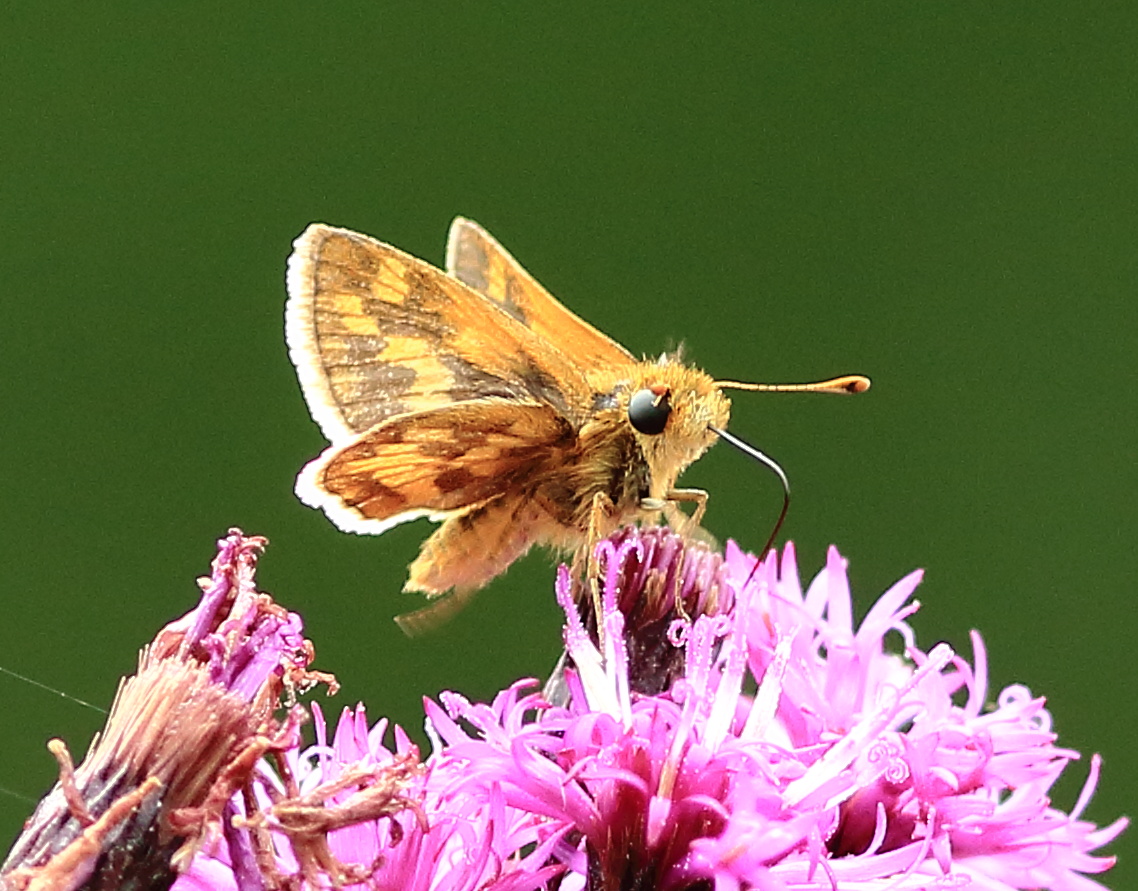The New York Ironweed, Vernonia noveboracensis (L.) Michx., in our garden blooms a lovely magenta.

It is a rare day when you will find me wearing anything magenta, it is far from “my” color, but in the garden it is magnificent. In addition to providing a splash of color to our garden, the plant serves as a magnet for some insects. So, I decided to do a photo essay of the insects.
Dragging out the camera, I started capturing images. I first got a picture of a Peck’s skipper, Polites peckius, one of the grass skippers; butterflies often considered difficult to identify. Quickly, I caught images of a silver spotted skipper, Epargyreus clarus; a Peck’s skipper, a cuckoo bee, a Peck’s skipper, a flower fly, and a Peck’s skipper. I could see a trend.

Peck’s skippers love this plant.
Reviewing my photos of butterflies I started in July, I learned that in early July, Peck’s skippers had a pulse along with sachems, Analopedes campestris.

Both were frequently seen in the lawn. In late August and early September, the Peck’s skippers are abundant once again. The sachem is not as abundant, but visits the ironweed.
In my yard, the Peck’s skippers feed on the New York Ironweed, great blue lobelia (Lobelia siphalitica), hosta (hosta sp.), blue mist flower (Conclinium coelestinum), Canada goldenrod (Solidago canadensis), and other plants. Since the larva of this species loves grasses, having a small portion of lawn with neighbors with who love lawns probably helps this species.
In my profession, there is a saying that “learning stops with the name.” To me, the learning starts with the name. Look at all those names above, each has its story, but lets focus on Polites peckius. The genus, like so many other genera of butterflies has an origin in mythology with Polites being either a friend of Odysseus or a Prince of Troy. Obviously, the species name honors someone. Who was Peck?
I found a wonderfully informative website, referenced below. William Kirby, a British entomologist, first described

Peck’s skipper in 1837. No one knows the origin of Kirby’s specimen, but Kirby decided to honor William Dandridge Peck, the first natural history professor at Harvard. He was born in 1763 and dies in 1822. is considered the first native American entomologist. He was a not a contemporary of Kirby, so he could not have been the source of Kirby’s type specimen. Undoubtedly, Kirby felt naming this butterfly Peck’s skipper honored the man.
During this time in American history, huge patches of forest were cleared for farms, which undoubtedly favored this grass loving species. In 1889, Samuel Hubbard Scudder, America’s premier entomologist of his day, wrote, “In New England it is everywhere the commonest of the [skippers]…” It still is.
Fortunately, this species provides a distinctive identification clue. Both the male and female, when seen with wings closed show two bands of yellow cells on the hind wing. One of these cells protrudes towards the edge of the wing, a clincher id mark. Unfortunately, the Peck’s skippers don’t always sit with wings folded. Sometimes their wings are held out flat. Other times the forewing is held up and the find wing flat.

I really nice field mark for the male is the black bar or stigma that separates the orange from the brown on the wing. Note how on the outside tip of the stigma there is an orange patch.
The female’s wings are darker without the stigma.

Once I learned what the butterfly looked like and its name, I now see them frequently. Lifelong learning is great!
References
https://en.wikipedia.org/wiki/Polites
https://www.butterfliesofmassachusetts.net/pecks.htm
https://peoplepill.com/people/william-dandridge-peck/
Glassberg, Jeffery, Butterflies through Binoculars, A Field Guide to Butterflies of the Boston-New York, Washington Region. Oxford University Press, New York, New York, 1993.

Comments
2 responses to “Pick a Peck”
I am delighted by your photos of Peck’s skippers! ….and how about the idea that some species thrive on our lawns!
As a relative newbie to native gardening, the photo of the iron weed with sachem is a good motivator!
Thank you for sharing your work,
Patricia
I enjoyed this post, Bob. In my northern Texas area Peck’s Skipper is listed as a stray encounter and I don’t remember ever seeing one. Since they do apparently occur regularly in Oklahoma I’ll start watching more closely for them.